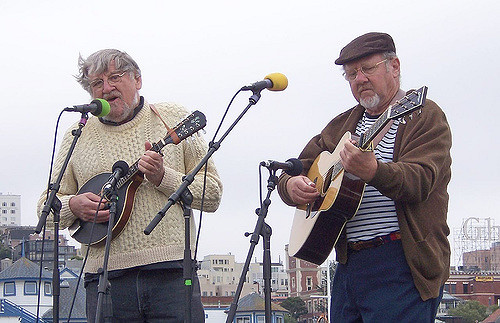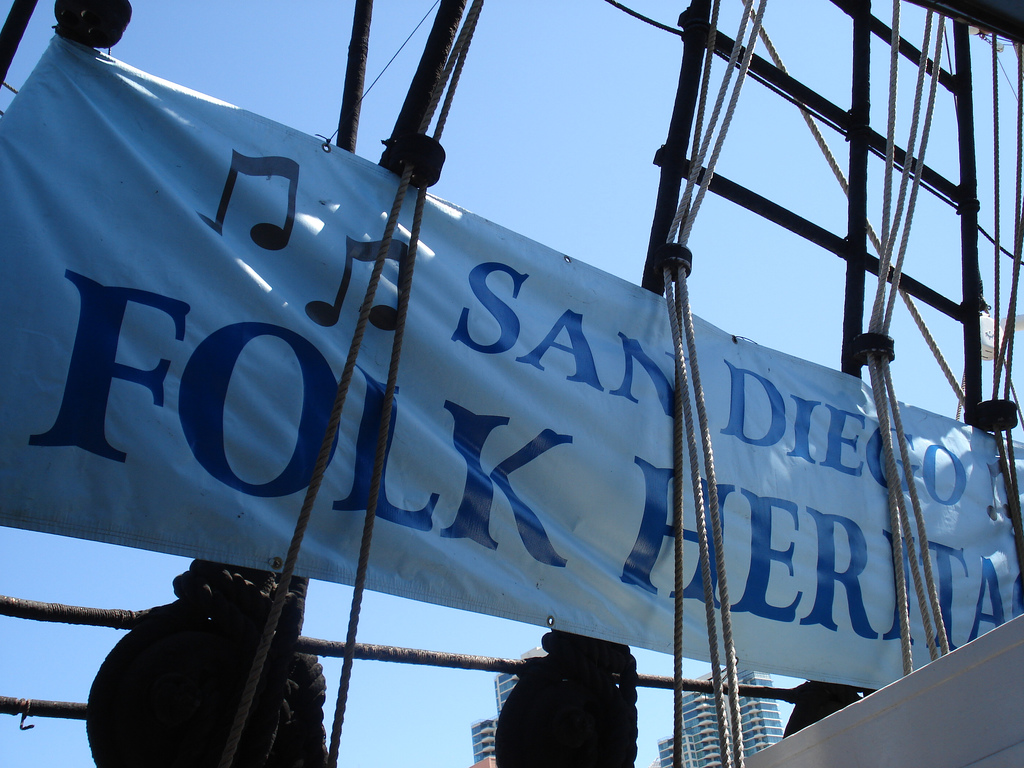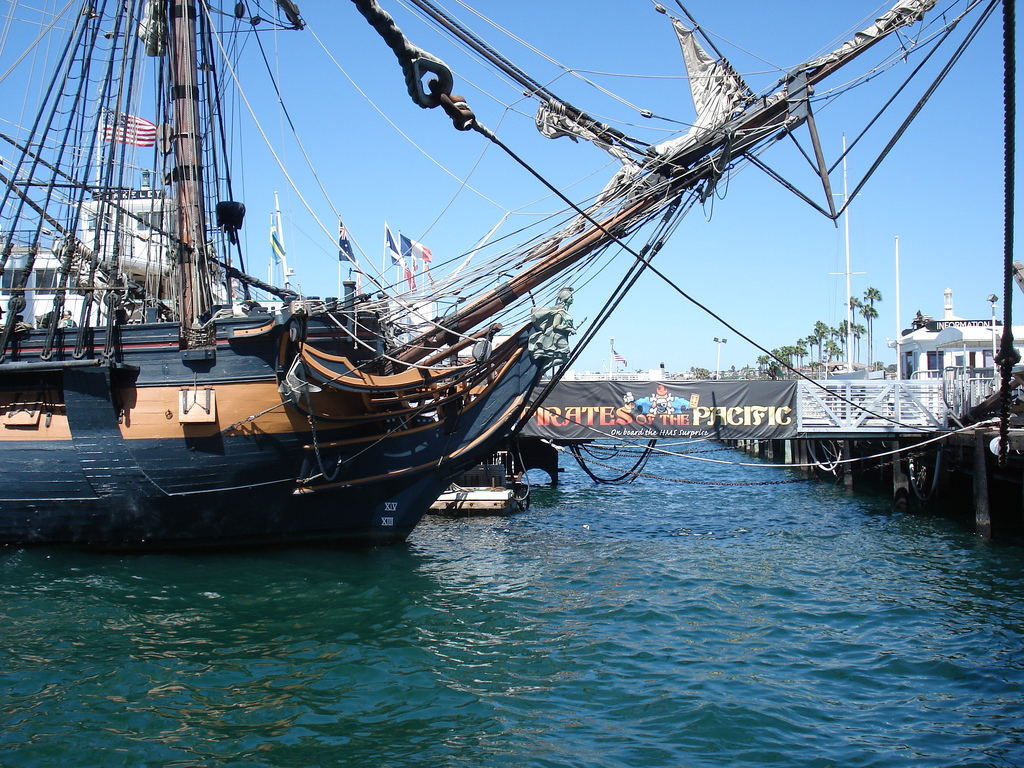He Sings Sea Songs By The Sea Shore
What should we do with the cosplay sailor?
I collect folk songs about shipwrecks and other maritime disasters, so it was with great excitement that I queued up my playlist of 64 songs about shipwrecks and drove from Los Angeles to San Diego, for the 25th Annual Sea Chantey Festival at the Maritime Museum. There are several sea chantey conventions held annually throughout the United States, but this is the only one on the west coast. The convention was held aboard the Star of India, a massive iron merchant vessel and the world’s oldest sailing ship still in active use, now docked in San Diego Harbor. I boarded just as the small audience of folk music enthusiasts was launching into the chorus of “Maggie May”: “Oh Maggie, Maggie May, They have taken her away,” about a seductive thief who robs sailors on leave.
A pop-up sun shade had been erected near the mainmast, with a small stage underneath and rows of folding chairs on deck. Throughout the day, a rotating cast of folk musicians would take the stage in 40-minute blocks, performing a mix of traditional and contemporary songs loosely themed around sailing. Members of the Jackstraws and The Chanteymen dedicated the first set to four fellow chantey singers who’d died in the last year, a sad consequence of the hobby’s aging male fan base. They performed each man’s favorite song: “Maggie May,” “The Whaler’s Tale” (with the delightfully singable chorus, “for I tell you, sir, those fish can think as well as you or me!”), “Fiddler’s Green,” and “Rolling Down to Old Maui,” which they described as “the pop hit of the chantey set.” It was a mostly white, male, middle-aged crowd, and half the audience was composed of other chantey singers waiting their turn at the stage. Curious tourists wandered on and off the ship, anchored beside a replica Spanish galleon and a salvaged Soviet submarine. A contingent of the singers’ wives sat knitting in time with the beat, some wearing matching band shirts.
A few of the singers wore full piratical costumes or assorted parts thereof, and some of the audience members wore the same, but most people were dressed in knee-length shorts, walking sandals, and a variety of sun hats and windbreakers in technical fabrics designed to protect aging skin from San Diego’s unrelenting mildness. There were also a few people (there are always a few people) wearing sundry accessories from the undifferentiated past: Mardi Gras beads, World War I-era sailor’s shirts, a sort of medieval corset laced up with nylon paracord.

Image: Scott F via Flickr
Sea chanties (derived from the French chanter and variously spelled shanty, chantey, or chanty) were originally work songs; sailors would sing them in unison while hoisting sails or pulling up anchors to coordinate their movements and enliven their labor. They derived from simple chants like “1-2-3-ho!” and the type of cadence calls still used today in the military. Chanties developed from work songs sung by African and Caribbean slaves as they would row river boats, stoke furnaces, or load cotton onto ocean-going ships, sometimes turning giant “cotton screws” to pack the cotton down into the hold. Lacking full-fledged verses and choruses, they were closer to call-and-response shouts than the folk songs performed at conventions today. Songs like “Rolling Down to Old Maui” are more properly called “forebitters,” songs sailors would sing at rest, not at work.
These original sea chanties appeared at a specific era in maritime history. After the War of 1812, there was a boom in maritime shipping. Ever looking to cut costs, American packet ships began using larger and larger vessels with smaller and smaller crews. Sailors were expected to maintain work tight schedules; the romantic idea of a life at sea, laboring in time with the wind and the tides, gave way to modern ideas about discipline and efficiency.
Today, musicologists divide chanties into those for hauling and those for heaving, with rhythms and pacing suited to each. “Blow the Man Down” is characterized as a long-drag or halyard chantey to be sung while hoisting the topsail, with two long pulls per line: “WAY, hey, BLOW the man down!” Short-drag chanties like “Haul Away Joe” were suited to quick, short bursts of pulling: “Way, haul away, haul away, JOE!” The ever-popular “Drunken Sailor” was sung on large military vessels, where up to 200 men would grab onto a rope and walk with it to the end of the boat, then circling around to grab on and walk again, like a human conveyer belt. “Heaving” chanties were made for continuous action turning winches or pumping handles. These chanties were longer, closer tosongs than chants, with distinct verses and choruses; some of the best-known are “John Brown’s Body” and “Heave Away Johnnies.” By the early 20th century, steam ships had replaced sail and much of the heavy manual labor on board was being done, tirelessly and tunelessly, by machines instead of men.

Image: Erin Stevenson O’Connor via Flickr
Though people have been singing songs in time to manual labor for centuries, the era of true sea chanties was only about 50 years (and all of it well after the golden age of piracy). Even in the 19th century, these chanties were viewed with nostalgia. The first printed collections of chanties date back to the 1880s, inspired by a sense that they represented a way of life that was already dying only a few decades after it was born. In 1882, only 40 years after Herman Melville wrote about the popularity of sea shanties, the New York writer William Alden compiled Sailors Songs, while writing
The “shanty-man”—the chorister of the old packet ship—has left no successors. In the place of a rousing “pulling song,” we now hear the rattle of the steam-winch; and the modern windlass worked by steam, or the modern steam-pump, gives us the clatter of cogwheels and the hiss of steam in place of the wild choruses of other days. Singing and steam are irreconcilable. The hoarse steam-whistle is the nearest approach to music that can exist in the hot, greasy atmosphere of the steam-engine.
Hundreds of sea chanties (as well as other folk songs about life at sea) were gathered up by folklorists, often with little attention paid to accuracy. These original songs soon joined dozens of more modern creations, and by the1960s Folk Revival, most of the best-known “sea chanties” never functioned as work songs at all. Songs like “The Whaler’s Tale” weren’t written to be sung while hauling up sails and setting anchors: they were written to be sung at sea chantey conventions.

Image: Erin Stevenson O’Connor via Flickr
Today historians and musicologists collect and catalog original work songs and their antecedents and write very dry papers about the difference between coastwise and longshore chanties (both performed by stevedores loading and unloading ships at shore), but their work has little impact on people who want to gather to sing about the vengeful whales on a lovely Sunday afternoon. And so, sailors and slaves become pirates, and work songs become drinking songs. Popular history sails blithely around the harbor with an eye patch and plaster parrot, while real history sits on the muddy bottom, sifting little shards of truth from the silt of the past.
But sailors were self-mythologizing even in their own time, their songs casting a life of unremitting toil as one of dashing adventure. Sitting aboard the Star of India, I was reminded of the Jimmy Buffett song “A Pirate Looks at Forty,” in which he sings, “Yes, I am a pirate, two hundred years too late/The cannons don’t thunder, there’s nothing to plunder/I’m an over forty victim of fate/Arriving too late, arriving too late.” (Again, chantey singers were not pirates, but this is distinction no one at a sea shanty convention is keen on making.) Today, sailors, one of the most racially heterogenous communities of the 19th-century, are reimagined as stalwart white men (and a few white women in low-cut bodices), and the songs of slaves, indentured servants, immigrants, and laborers as anthems for office workers longing to be free. It’s not just Jimmy Buffett: everyone wants to be a pirate. Pirates wanted to be pirates, too.
I want to believe good things can come from a romantic reimagining of the past. I love Victorian-era medievalists and fake ornamental castle ruins. I still enjoy the goofy anachronisms of folk revivalists and Parrotheads, but even harmless nostalgia doesn’t feel so harmless now. The spectacle of neo-Nazis in polo shirts carrying party-store tiki torches in defense of Confederate statues erected in the 20th century is a twisted form of ahistorical cosplay. The noble Confederate soldier is a more insidious and wicked lie than the dashing, chantey-singing pirate, but it’s not hard to see the parallels between criminals recast as quixotic romantics, a dying breed of real men. Nor is it hard to draw parallels between white-washing African work songs and imagining an all-white America that never was (or ought to be). Accountants in eyepatches hoisting margaritas to “Rolling Down to Old Maui,” long for an imaginary era of “greatness” and they won’t let the facts stand in their way. It’s dangerous to treat history like a toy chest filled with plastic broad swords and pirate hats. I don’t know how to enjoy Renaissance Faires and steampunk corsets and sea chantey conventions in the time of MAGA, but perhaps we start by interrogating the myths and motives behind our nostalgia, and by honoring the unglamorous work of uncovering the muddy truth.
